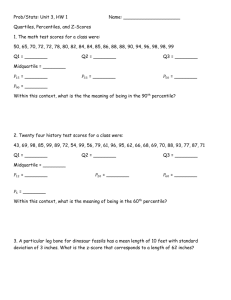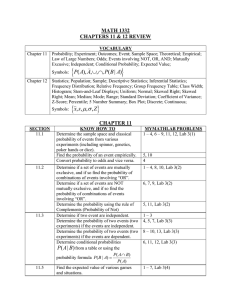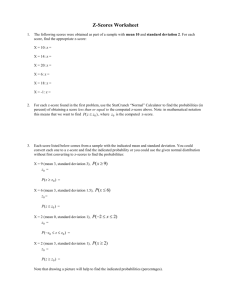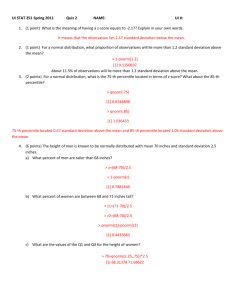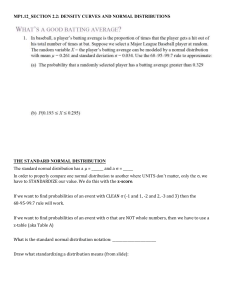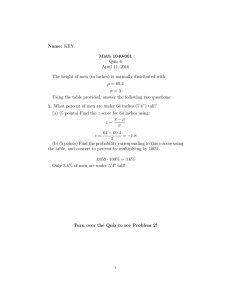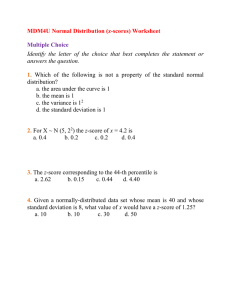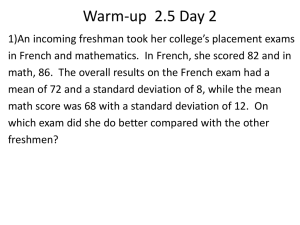Section 4.3 notes, Completed
advertisement
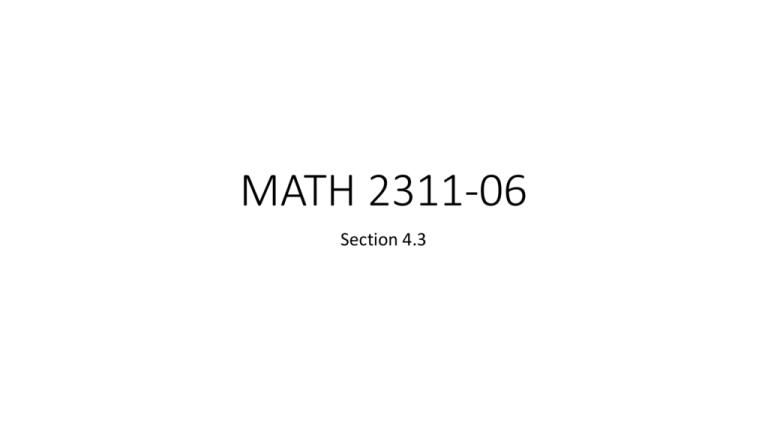
MATH 2311-06 Section 4.3 Standard Normal Calculations As suggested in the previous section, all normal distributions share many common properties. In fact, if change the units to σ and center the graph at μ=0, all normal distributions would be exactly the same. This is called standardizing. If x is an observation from a normal distribution with mean μ and standard deviation σ, the standardized value of x is called the z-score and is computed with the formula below. The Z-Score A z-score tells us how many standard deviations the observed value falls from the mean. We can use z-scores to “standardize” values that are on different scales to compare them. Example: Bon took the ACT and scored 31. Craig took the SAT and scored (CR+M) 1390. If both tests are normally distributed, who did better? The ACT has a mean of 21.1 and a standard deviation of 4.7. The SAT has a mean of 1010 and a standard deviation of 174.5. The standard normal distribution is the normal distribution with N(0,1): Little known fact: The Normal Distribution Curve has an equation of the following: 1 −𝑥 2 2 𝑦= 𝑒 2𝜋 Using Tables from the Textbook: Table A in your appendix gives areas under the standard normal curve for values of z. The table entry for each value of z gives the area under the curve to the left of z – in other words, it gives p(Z < z) . https://www.casa.uh.edu/CourseWare2008/Books/p/Math/2311/TB/in dex.html Example: Using Table A, find the following probabilities: A. p(Z < −1.06) B. p(Z < 2.15) C. p(Z > 2.15) D. p(−1.06 < Z < 2.15) Now let’s repeat with calculator and R-Studio. If we want to use the table for probabilities and are not given z, we must compute the zscore using the formula above. Example: Popper 8 If X has distribution N(100,15), standardize X and use Table A to find the following probabilities: 1. p(X < 80) a. 0.9082 b. 0.9999 2. p(X >105) a. 0.6298 b. 0.0004 3. p(80 < X <105) a. 0.6298 b. 0.0000 c. 0.1333 d. 0.0918 c. 0.3707 d. 0.9996 c. 0.5380 d. 0.0918 Known Percentile Rank Now, let’s suppose we know the percentile rank or the probability and want to find the corresponding z-score. We can use Table A and look up the percentile (remember, it shows the area to the left) or we can use the command invNorm(percent) on the TI or qnorm(percent) in R. Example: Find the value of c so that A. P(Z < c) = 0.7704 B. P(Z > c) = 0.006 C. P(−c < Z < c) = 0.966 Another example: Suppose you rank in the top 10% of your class. If the mean gpa is 2.7 and the standard deviation is 0.59, what is your gpa? (Assume a normal distribution).


